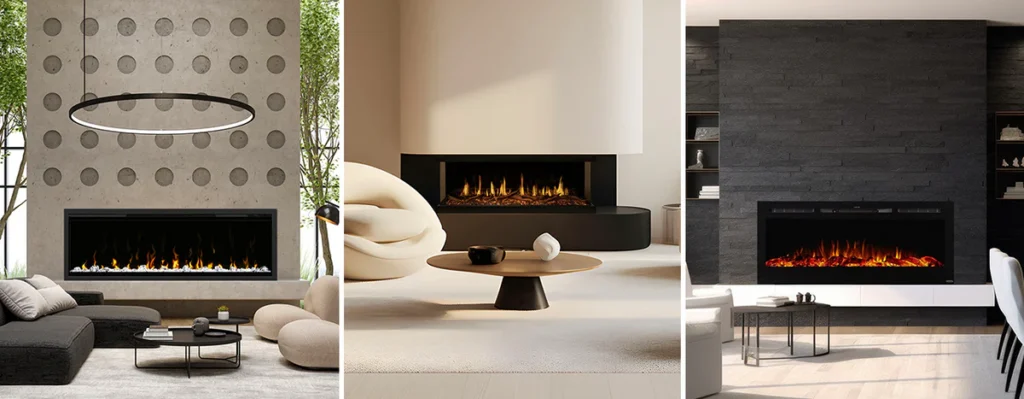Blog
Shop Fireplaces with Energy-Saving Features
A fireplace is not just a source of warmth—it’s an essential feature that adds ambiance, style, and value to your home. However, as energy efficiency becomes a priority for homeowners, it’s important to choose fireplaces that not only enhance your living space but also help reduce energy consumption and costs. Fortunately, there are many fireplaces with energy-saving features that combine functionality, sustainability, and style.
In this guide, we’ll explore the best energy-efficient fireplaces, their features, and how to select the perfect one for your home. Let’s dive into why these fireplaces are worth the investment and how they can help you save on energy bills while keeping your home warm and cozy.
Why Choose an Energy-Saving Fireplace?

1. Lower Energy Costs
Energy-efficient fireplaces provide supplemental heat to specific rooms, reducing reliance on central heating systems and lowering overall energy consumption.
2. Eco-Friendly Design
Modern fireplaces with energy-saving features are designed to use fuel efficiently, minimizing emissions and reducing your carbon footprint.
3. Consistent Heating
Energy-saving fireplaces deliver consistent warmth while maintaining better heat distribution throughout your living space.
4. Smart Features
Advanced models come with programmable thermostats, timers, and remote controls to optimize heating without wasting energy.
Key Energy-Saving Features to Look For
1. Efficient Heat Output
- Measured in BTUs (British Thermal Units), higher-efficiency fireplaces convert more fuel into heat with minimal waste.
- Look for models with high AFUE (Annual Fuel Utilization Efficiency) ratings.
2. Zone Heating
- Fireplaces with zone heating capabilities allow you to warm specific areas, reducing the need to heat the entire home.
3. Smart Thermostats
- Built-in thermostats and programmable timers let you control heat output based on your schedule and preferences.
4. LED Flame Technology
- In electric fireplaces, LED lights simulate flames while consuming less energy compared to traditional bulbs.
5. Sealed Combustion
- Gas fireplaces with sealed combustion systems draw air from outside the home, improving efficiency and safety by preventing heat loss.
6. Infrared Heating
- Infrared technology in electric fireplaces provides direct, efficient heating to people and objects in the room without wasting energy on the air.
Types of Energy-Efficient Fireplaces
1. Electric Fireplaces
Electric fireplaces are a top choice for energy efficiency, offering customizable heat settings and low energy consumption.
- Features:
- Plug-and-play installation with no need for chimneys or vents.
- LED flame effects for year-round ambiance without heat.
- Zone heating to target specific areas.
- Energy-Saving Benefits:
- Energy-efficient models use as little as 1,500 watts.
- Timer functions ensure the fireplace shuts off automatically.
2. Gas Fireplaces
Gas fireplaces provide real flames with high heat output while minimizing energy waste.
- Features:
- Sealed combustion for efficient fuel use.
- Direct vent or ventless options to maximize heat retention.
- Smart thermostats for precise temperature control.
- Energy-Saving Benefits:
- Natural gas and propane are clean-burning fuels with low emissions.
- Direct vent models reduce heat loss through chimneys.
3. Ethanol Fireplaces
Ethanol fireplaces offer eco-friendly, ventless designs with real flames.
- Features:
- Uses renewable bioethanol fuel.
- Produces minimal emissions and no soot or ash.
- Ideal for small spaces and supplemental heating.
- Energy-Saving Benefits:
- Ventless operation prevents heat loss.
- Efficient combustion ensures maximum heat output per unit of fuel.
4. Pellet Fireplaces
Pellet fireplaces burn compressed wood pellets for consistent and efficient heat.
- Features:
- Automatic feeding systems for steady heat output.
- Programmable controls for energy optimization.
- Requires minimal maintenance compared to traditional wood-burning fireplaces.
- Energy-Saving Benefits:
- High-efficiency models can achieve AFUE ratings of 80% or more.
- Renewable and sustainable fuel source.
5. Infrared Quartz Fireplaces
Infrared fireplaces provide targeted heating by warming objects directly.
- Features:
- Heats up to 1,000 square feet without drying out the air.
- Built-in thermostats and timers for controlled heating.
- Energy-Saving Benefits:
- Provides warmth instantly with minimal energy consumption.
- Ideal for zone heating in medium to large spaces.
Top Energy-Efficient Fireplaces to Consider

1. R.W. Flame Electric Fireplace
- Type: Wall-mounted electric fireplace.
- Energy-Saving Features:
- LED technology for realistic flames.
- Adjustable heat settings and timer functions.
- Slim design for efficient space usage.
- Why It’s Great: Combines style, affordability, and energy efficiency.
2. Napoleon Ascent Series Gas Fireplace
- Type: Direct vent gas fireplace.
- Energy-Saving Features:
- Sealed combustion system for improved efficiency.
- High BTU output with adjustable thermostats.
- Why It’s Great: Offers the warmth of real flames with minimal heat loss.
3. Duraflame Infrared Quartz Fireplace
- Type: Freestanding electric fireplace.
- Energy-Saving Features:
- Infrared heating for quick, targeted warmth.
- Programmable thermostat and overheat protection.
- Why It’s Great: Perfect for zone heating in medium-sized rooms.
4. EcoSmart Flex Ethanol Fireplace
- Type: Ethanol fireplace.
- Energy-Saving Features:
- Ventless design eliminates heat loss.
- Burns clean bioethanol for eco-friendly warmth.
- Why It’s Great: Sleek, modern, and sustainable.
5. Harman XXV Pellet Stove
- Type: Pellet fireplace.
- Energy-Saving Features:
- High AFUE rating for efficient heating.
- Programmable controls for optimized energy use.
- Why It’s Great: Ideal for large spaces and eco-conscious homeowners.
How to Choose the Right Energy-Efficient Fireplace
1. Assess Your Heating Needs
- Consider the size of the space you want to heat.
- Determine if the fireplace will serve as a primary or supplemental heat source.
2. Evaluate Fuel Options
- Electric: Low-maintenance and easy to install.
- Gas: High heat output with real flames.
- Ethanol: Eco-friendly and ventless.
- Pellet: Sustainable with consistent heating.
3. Consider Installation Requirements
- Electric and ethanol fireplaces require minimal setup.
- Gas and pellet fireplaces may need professional installation.
4. Check Energy Ratings
- Look for high AFUE ratings for gas and pellet fireplaces.
- Ensure electric models have energy-saving settings like timers and thermostats.
Tips for Maximizing Energy Efficiency
- Use Zone Heating:
- Focus on warming the rooms you use most instead of heating the entire home.
- Install Proper Insulation:
- Ensure your fireplace area is well-insulated to retain heat.
- Maintain Your Fireplace:
- Clean and service your fireplace regularly to keep it running efficiently.
- Combine with Smart Home Systems:
- Use smart thermostats or timers to control heating based on your schedule.
Conclusion
An energy-saving fireplace is an excellent addition to any home, providing warmth, ambiance, and cost savings. Whether you prefer the simplicity of an electric fireplace, the realism of a gas model, or the sustainability of ethanol or pellet options, there’s a fireplace to match your needs. Explore the options listed above and enjoy a cozy, energy-efficient home this winter.
Shop now and transform your space with a fireplace that’s both stylish and eco-friendly!


